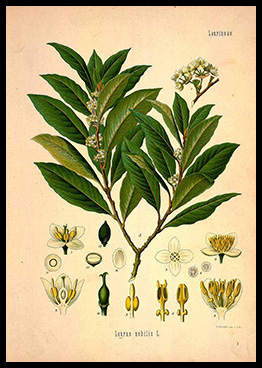Bay and the Moon
By Audrey Stallsmith

The bay trees in our country are all wither'd,
And meteors fright the fixed stars of heaven;
The pale-fac'd moon looks bloody on the earth,
And lean-look'd prophets whisper fearful change. . .
William Shakespeare, Richard II, ii, 4
As you can conclude from the above ominous quote, the ancients considered bay trees such symbols of success and prosperity that their death presaged “fearful change.” In fact, according to Shakespeare, it was as bad an omen as blood on the moon.
I vaguely recall owning a potted bay once myself, since that tree only survives winters outdoors in USDA zones higher than 7. I’m guessing that mine “wither’d” since I don’t have it now, but I don’t recall the “fearful change” part!
Still, I’m wishing that I had taken better care of it. So, when I recently saw bay tree seeds advertised, I grabbed them while I could get them since they tend to be hard to find.
Psalm 37:35 confirms the plant’s ancient association with success and prosperity by the complaint that “I have seen the wicked in great power and spreading himself like a green bay tree.” The original victorious Olympic athletes wore wreathes of bay leaves instead of gold medals.
We can see why the tree came to stand for “glory” in the Language of Flowers, its wreathes often perched atop the pates of Roman Caesars and generals as well. Its botanical name, Laurus nobilis derives from the Celtic laur (“green”) and the Latin nobilis (“noble”).
In his 1838 book, The Trees and Shrubs of Britain, J. C. Loudon notes that “it was a custom in the Middle Ages to place wreathes of laurel with the berries on, on the heads of those poets who had particularly distinguished themselves: hence, our expression, poet laureate. Students who have taken their degrees at the university are called bachelors. . .which is derived from the Latin baccalaureus, a laurel berry. These students were not allowed to marry. . .and, in time, all single men were called bachelors.”
However, according to mythology, the laurel is supposed to have sprung from a single woman! Fleeing the advances of Apollo, Daphne, daughter of the river god Peneus, called on her father for help and he turned her into a tree. (I’m not sure I really would call that help!)
Although the bay can grow to 60 feet with clusters of small yellow flowers in late spring and early summer, it usually doesn’t surpass 40 feet, those flowers being followed on female trees by oval green berries which ripen to black. It may have been revered for the glossy luster of its 2 to 4-inch leaves as well as for its pleasant fragrance and its medicinal and culinary uses.
One of the “good” herbs, bay supposedly protected against baleful influences from curses to contagions, as well as protecting stored food from insects. Employed by fortunetellers for divination, it also was supposed to be diaphoretic (increase sweating to break fevers) in moderate doses and emetic (cause vomiting) in large ones, it also was used to treat rheumatism and liver problems. In his Green Pharmacy books, James Duke recommends bay for the prevention of migraines and increasing the efficiency of insulin.
But, of course, it most commonly stars as a recipe ingredient, especially in soups and stews which contain chicken, fish, or beans. Although a bay leaf imparts mellow flavor to those broths, you should remove and discard it before serving the soup as the leaf itself remains bitter. Stiff and sharp enough to be a choking hazard, it also could scratch your esophagus on the way down!
And, although edible to humans, bay reportedly can be dangerous to pets and livestock. Other types of laurel—such as cherry laurel and mountain laurel—are poisonous to both people and animals.
So, always be sure that it really is bay laurel which you are adding to your soup or the change you experience may, indeed, be a fearful one. And keep in mind that trusting an herb to provide you success and/or protection is about as effective as baying at the moon!
Laurus nobilis image is from Kohler’s Medizinal Pflanzen, courtesy of plantillustrations.org.








